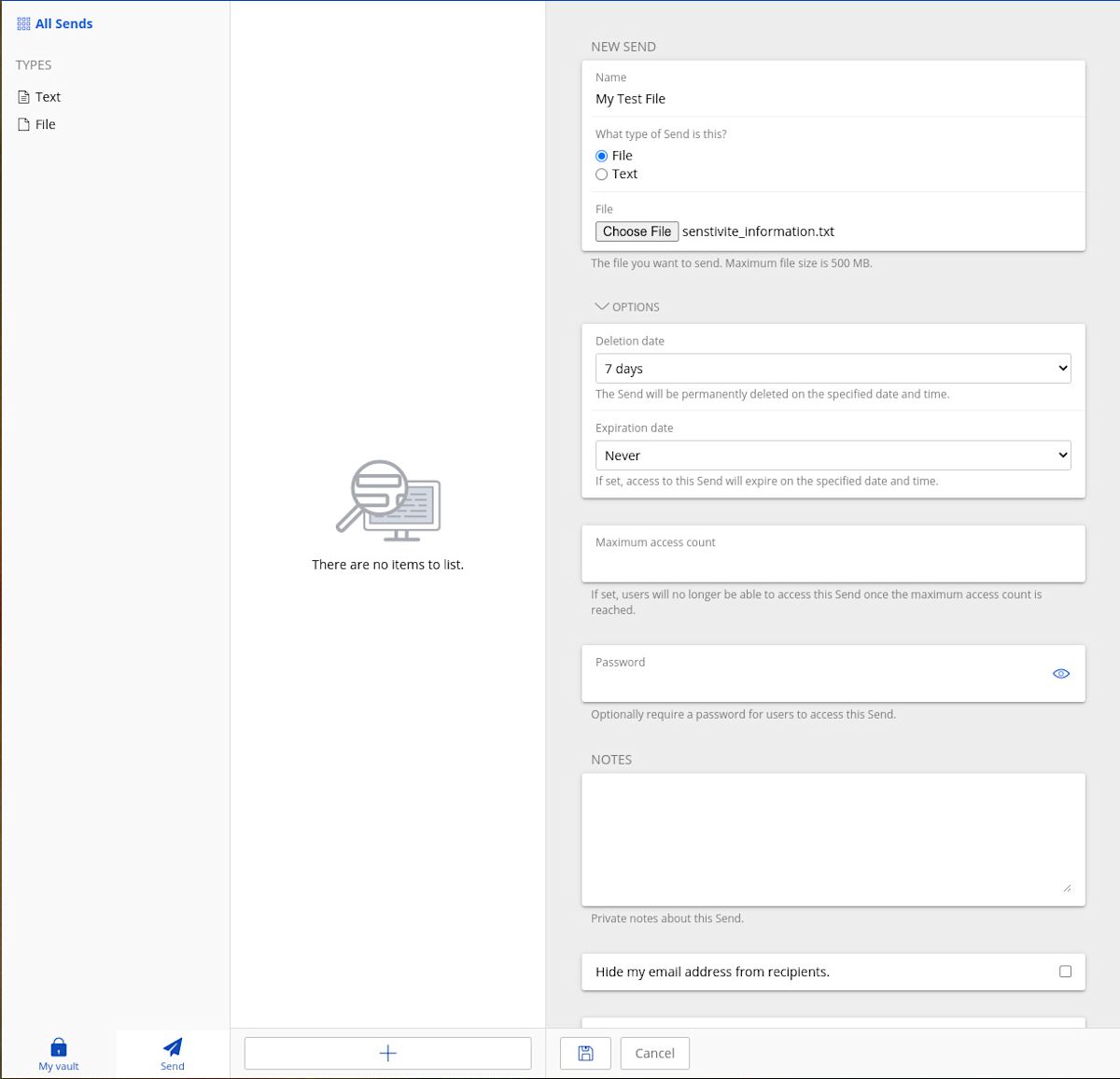- Blog
- How to share files securely with Bitwarden Send
For the longest time, those needing to share files with an individual or a group would do so via email. However, there are two common challenges with this method. First, as file sizes continue to grow (especially with the proliferation of video file sharing), more and more email services can’t keep up with that expansion. Many email services have file limits of less than 100 MB, while files are often much larger. Second, privacy and security have become critical, so users need to learn how to share files via more secure methods.
Unless you are encrypting your email, when you share a file via email, it's simply not secure. That can be a problem, especially when sharing files that contain sensitive information like bank account data, personal information, legal content, tax information, or company secrets. If that's the case, the second that information is shared via an unencrypted email with an accountant, lawyer, or CEO, the risk of exposure increases. That file’s security is now dependent on the physical security of your devices and email account and relying on that service to never experience a data breach; according to research, that may be unrealistic, with 60% of companies reporting a recent data breach.
You may not think you even have sensitive information to share. You may not own a company, have classified documents on your hard drive, or feel like any information you've saved is of any consequence. But everyone, no matter who they are, still has plenty of information others might want to access. For example, have you ever had to share your social security number with a company? If so, did you simply type it into the body of an email and send it off, or include it in an attachment? If so, you've put yourself at risk. Unencrypted emails can be intercepted by anyone with the skills to do so.
Maybe you've had to scan and copy a deed, a will, or a tax document and send it to a lawyer. Did you attach that file to an email and send it? Or, perhaps you uploaded that document to Google Drive and shared it with the built-in sharing system. You might have taken a photo of such a document with your phone and then shared it with either Android or iOS sharing tools. What would you do if you accidentally shared that document or photo with the wrong person?
The scenarios are limitless. Because of this, it is necessary to learn how to share files while keeping sensitive information secure.
Everyone knows email - however, you might not know that your emails are probably all being sent via plain text. This means the email and any associated attachments aren't encrypted. Encrypting your own email is not easy for the average user. Not only do you have to enable the feature on your email client of choice, but you also have to receive public encryption keys from those you wish to share encrypted emails with. On top of that, services like Gmail don't support third-party encryption tools like PGP.
Fortunately, password managers like Bitwarden make this very easy. With Bitwarden Send, you can create a new Send that includes a file with sensitive information. Bitwarden Send allows you to:
Send secure text.
Send files.
Set an automatic deletion date.
Set an expiration date.
Set a maximum access count.
Create a password that users will need to access the send.
Add notes.
Hide your email address from recipients using Bitwarden Send.
Manually deactivate the Send so no one can access it.
Creating a secure Send in Bitwarden is very simple and can be done completely within the mobile, desktop, or web-based GUI (Figure 1).

As an example, you may want to share an account password with your child who just left for college. Here's a simple way to do that:
First, inform the child they'll receive the password (maybe do this over the phone or via email).
Open Bitwarden and click on the Send tab.
Give the Send a name.
Select Text from the What Type of Send is this? drop-down menu.
Type or paste the password in the Text area.
Set an optional password (you'll need to communicate that password to the recipient).
Click Save.
Copy the Send link provided in the SHARE section near the bottom.
Send the link to the recipient either via email or text.
Once the recipient has accessed the Send, manually deactivate it if you did not set an expiration or deletion date.
You can do the same thing with a file. Instead of selecting Text, during the creation of the Send, you'd select File, click Choose File, locate the file in your desktop file manager, and then complete the creation of the Send as you did in the previous example. With this method, you can securely send confidential contracts, banking details, and other sensitive information without worrying it will be compromised in transit.
It doesn't take much effort to learn how to share sensitive information. With the help of tools like Bitwarden Send, that process is made even easier. Just remember to manage those Sends carefully and deactivate them once they've been received. Once you've deactivated a Send, you can just as easily reactivate and share it again. Until you delete that Send, it'll be available for you to use from within your Bitwarden password manager.
Always use extra care when sharing sensitive information with another person or organization.
Get started with Bitwarden
Are you ready to get started with Bitwarden? Start a free trial for your business or sign up for a free individual account.
